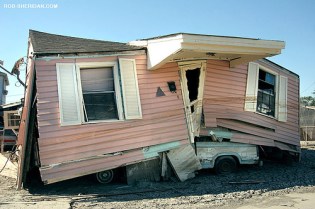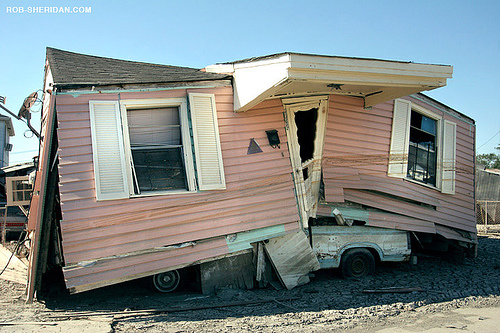
Photo by Rob Sheridan.
When people say, “Call the National Guard,” they really mean Craig Fugate. As head of the Federal Emergency Management Agency (FEMA), he’s the guy who swoops in after a tornado or flood to clean up the mess with executive muscle and a pool of cash from the federal treasury. So perhaps it’s no great surprise that he supports efforts to create buildings that are essentially apocalypse-proof: For this guy, every day is another disaster.
Of course, there’s also the fact that FEMA has actually been working on credit. “I owe you a lot of money from the National Flood Insurance Program — about $18 billion,” Fugate told a group at the National Press Club last week. “Those are payouts from 2005 hurricane season.”
You may remember that season for its unruly offspring: Dennis, Emily, Katrina, Rita, and Wilma. And climate scientists tell us there are many more to come. “We cannot afford to continue to respond to disasters and suffer impacts — particularly looking at large-scale catastrophic disasters — under the current program,” Fugate said. “It will fail.”
The solution? Get smarter about how and where we build.
Fugate was at the Press Club to help roll out a new report by University of Michigan researchers and the U.S. Green Building Council that looks at “climate resiliency” — constructing buildings that can withstand the coming deluge, drought, or (insert your disaster of choice). It’s early yet, but there may be a day when, if you want to get your house LEED certified, you’ll need to prove not just that it is eco-friendly today, but that it can survive Mother Nature’s worst in order to be so a few decades from now.
That may or may not be the case with today’s green buildings, says Green Building Council vice president of research Chris Pyke. When designing buildings, engineers use something called a “typical meteorological year,” which is derived from past climate conditions, he explains. “When they do that, they’re baking yesterday’s weather into your building today and hoping that it will perform tomorrow.”
Given climate change projections over the coming decades, that could be a recipe for disaster. For example, many of today’s green buildings rely on low nighttime temperatures to cool them down after hot days. But “heat storms,” which are on the rise in places like California and Texas, keep temperatures high all night and don’t allow that natural nocturnal cooling. Building inhabitants will have to find new cooling strategies, or stew in their own juices.
So the Green Building Council, an organization that has until now focused almost entirely on reducing our contributions to climate change, has turned its attention to the inevitable impacts of those contributions we’ve already made.
The authors of the new report, called Green Building and Climate Resilience [PDF], went region-by-region to identify the risks associated with a changing climate. The list looks like the 10 Plagues, minus the rivers turning to blood. (Whoops! There goes that one.) A partial accounting includes more extreme heat events, shorter winters, more frequent droughts, rising sea levels, higher-intensity hurricanes and storm surges, heavier downpours, declining air quality, a rise in coastal erosion, insect infestations, and more severe wildfire seasons.
If there’s good news here, it’s that a lot of the things we’re doing to green our buildings today will also make them more resilient in the long run. The researchers call these “no regrets” measures, and they include everything from heavily insulated walls and ceilings to reflective and green roofs.
“We know that we’re baking in climate assumptions to our buildings,” Pyke says. “But we found twice as many strategies where we could use [green building standards] to adapt to climate change than we did sensitivities.”
It will be a while yet before the Green Building Council is offering an “Apocalypse Friendly” seal of approval (and, OK, they don’t use the word apocalypse), but Pyke says the concept of climate resiliency is catching on. In the U.K., regulators are already requiring new public buildings to take climate change into account.
Stateside, Fugate says one of the biggest challenges will be convincing local planning boards and building inspectors that climate change is not only real, but worth preparing for.
“How many times did you hear last year, ‘This is a hundred-year event’? We had one the year before that was categorized as a 500-year event. People are going, ‘Well, then we don’t have to worry for another 500 years,’” he said.
“We’ve had some of the worst winters on record. We’ve had some of the worst fire seasons on record. We’ve had some of the worst tornadoes since the 1950s. Vermont got hit with a tropical storm. That’s all in one year,” he said. “Risk that is not mitigated, that is not factored into community resiliency … often sets up false economies that say, ‘As long as somebody comes in and makes us whole, we can keep doing what we’re doing.’ What if we reach the point where we’re not able to subsidize that?”
Better to prepare for the coming storms now, so climate change doesn’t blast our homes off the map, or just render them uninhabitable. It will cost a little more up front — but it will save us boatloads when the next Katrina blows through.
Watch Craig Fugate’s entire National Press Club speech here.



